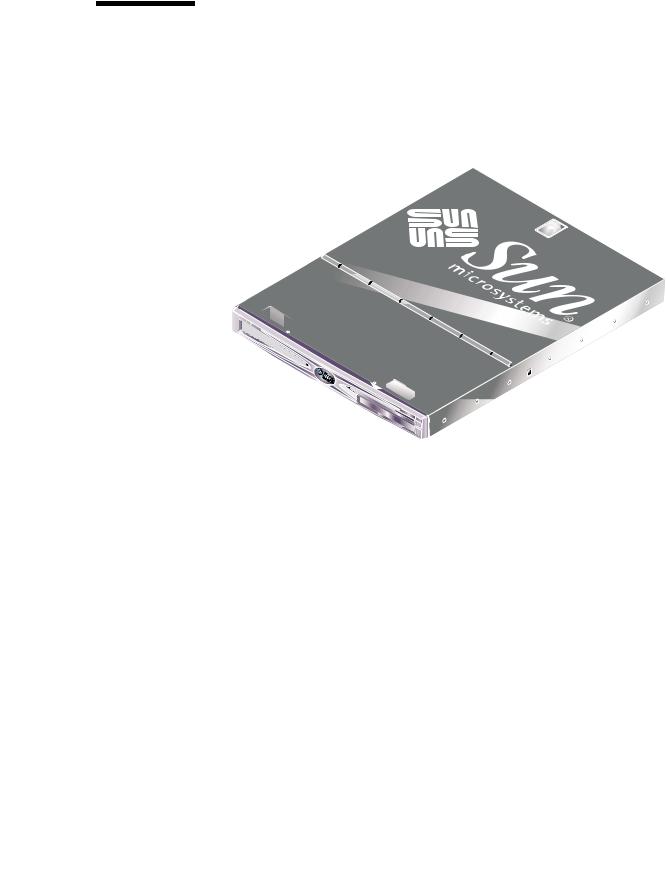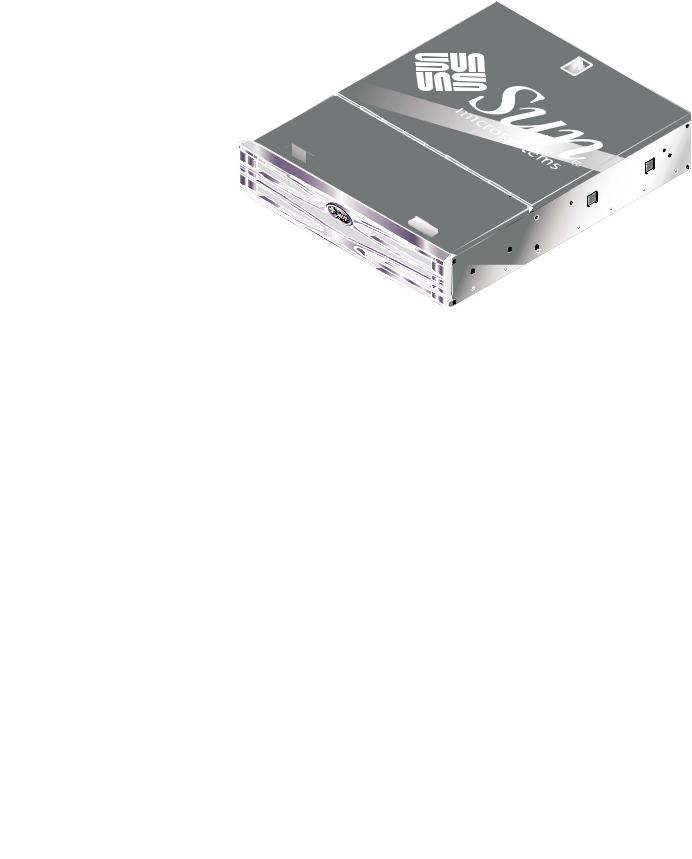Sun V240, V210 User Manual

Sun Fire™ V210 and V240 Servers
Installation Guide
Sun Microsystems, Inc. 4150 Network Circle
Santa Clara, CA 95054 U.S.A. 650-960-1300
Part No. 816-4825-11
April 2003, Revision A
Send comments about this document to: docfeedback@sun.com

Copyright 2002 Sun Microsystems, Inc., 4150 Network Circle, Santa Clara, California 95054, U.S.A. All rights reserved.
Sun Microsystems, Inc. has intellectual property rights relating to technology embodied in the product that is described in this document. In particular, and without limitation, these intellectual property rights may include one or more of the U.S. patents listed at http://www.sun.com/patents and one or more additional patents or pending patent applications in the U.S. and in other countries.
This document and the product to which it pertains are distributed under licenses restricting their use, copying, distribution, and decompilation. No part of the product or of this document may be reproduced in any form by any means without prior written authorization of Sun and its licensors, if any.
Third-party software, including font technology, is copyrighted and licensed from Sun suppliers.
Parts of the product may be derived from Berkeley BSD systems, licensed from the University of California. UNIX is a registered trademark in the U.S. and in other countries, exclusively licensed through X/Open Company, Ltd.
Sun, Sun Microsystems, the Sun logo, AnswerBook2, docs.sun.com, Sun Fire, and Solaris are trademarks or registered trademarks of Sun Microsystems, Inc. in the U.S. and in other countries.
All SPARC trademarks are used under license and are trademarks or registered trademarks of SPARC International, Inc. in the U.S. and in other countries. Products bearing SPARC trademarks are based upon an architecture developed by Sun Microsystems, Inc. The Energy Star logo is a registered trademark of EPA.
The OPEN LOOK and Sun™ Graphical User Interface was developed by Sun Microsystems, Inc. for its users and licensees. Sun acknowledges the pioneering efforts of Xerox in researching and developing the concept of visual or graphical user interfaces for the computer industry. Sun holds a non-exclusive license from Xerox to the Xerox Graphical User Interface, which license also covers Sun’s licensees who implement OPEN LOOK GUIs and otherwise comply with Sun’s written license agreements.
Use, duplication, or disclosure by the U.S. Government is subject to restrictions set forth in the Sun Microsystems, Inc. license agreements and as provided in DFARS 227.7202-1(a) and 227.7202-3(a) (1995), DFARS 252.227-7013(c)(1)(ii) (Oct. 1998), FAR 12.212(a) (1995), FAR 52.227-19, or FAR 52.227-14 (ALT III), as applicable.
DOCUMENTATION IS PROVIDED "AS IS" AND ALL EXPRESS OR IMPLIED CONDITIONS, REPRESENTATIONS AND WARRANTIES, INCLUDING ANY IMPLIED WARRANTY OF MERCHANTABILITY, FITNESS FOR A PARTICULAR PURPOSE OR NON-INFRINGEMENT, ARE DISCLAIMED, EXCEPT TO THE EXTENT THAT SUCH DISCLAIMERS ARE HELD TO BE LEGALLY INVALID.
Copyright 2002 Sun Microsystems, Inc., 4150 Network Circle, Santa Clara, California 95054, Etats-Unis. Tous droits réservés.
Sun Microsystems, Inc. a les droits de propriété intellectuels relatants à la technologie incorporée dans le produit qui est décrit dans ce document. En particulier, et sans la limitation, ces droits de propriété intellectuels peuvent inclure un ou plus des brevets américains énumérés à http://www.sun.com/patents et un ou les brevets plus supplémentaires ou les applications de brevet en attente dans les Etats-Unis et dans les autres pays.
Ce produit ou document est protégé par un copyright et distribué avec des licences qui en restreignent l’utilisation, la copie, la distribution, et la décompilation. Aucune partie de ce produit ou document ne peut être reproduite sous aucune forme, parquelque moyen que ce soit, sans l’autorisation préalable et écrite de Sun et de ses bailleurs de licence, s’il y ena.
Le logiciel détenu par des tiers, et qui comprend la technologie relative aux polices de caractères, est protégé par un copyright et licencié par des fournisseurs de Sun.
Des parties de ce produit pourront être dérivées des systèmes Berkeley BSD licenciés par l’Université de Californie. UNIX est une marque déposée aux Etats-Unis et dans d’autres pays et licenciée exclusivement par X/Open Company, Ltd.
Sun, Sun Microsystems, le logo Sun, AnswerBook2, docs.sun.com, Sun Fire, et Solaris sont des marques de fabrique ou des marques déposées de Sun Microsystems, Inc. aux Etats-Unis et dans d’autres pays.
Toutes les marques SPARC sont utilisées sous licence et sont des marques de fabrique ou des marques déposées de SPARC International, Inc. aux Etats-Unis et dans d’autres pays. Les produits protant les marques SPARC sont basés sur une architecture développée par Sun Microsystems, Inc.
L’interface d’utilisation graphique OPEN LOOK et Sun™ a été développée par Sun Microsystems, Inc. pour ses utilisateurs et licenciés. Sun reconnaît les efforts de pionniers de Xerox pour la recherche et le développment du concept des interfaces d’utilisation visuelle ou graphique pour l’industrie de l’informatique. Sun détient une license non exclusive do Xerox sur l’interface d’utilisation graphique Xerox, cette licence couvrant également les licenciées de Sun qui mettent en place l’interface d ’utilisation graphique OPEN LOOK et qui en outre se conforment aux licences écrites de Sun.
LA DOCUMENTATION EST FOURNIE "EN L’ÉTAT" ET TOUTES AUTRES CONDITIONS, DECLARATIONS ET GARANTIES EXPRESSES OU TACITES SONT FORMELLEMENT EXCLUES, DANS LA MESURE AUTORISEE PAR LA LOI APPLICABLE, Y COMPRIS NOTAMMENT TOUTE GARANTIE IMPLICITE RELATIVE A LA QUALITE MARCHANDE, A L’APTITUDE A UNE UTILISATION PARTICULIERE OU A L’ABSENCE DE CONTREFAÇON.
Please
Recycle

Contents
|
Contents iii |
|
|
|
|
|
Figures |
vii |
|
|
|
|
Tables |
ix |
|
|
|
|
Preface |
xi |
|
|
|
1. |
Introduction to the Sun Fire V210 and V240 Servers 1 |
||||
|
Overview of the Sun Fire V210 and V240 Servers 2 |
||||
|
Features 3 |
|
|
|
|
|
Differentiating Features |
4 |
|||
|
Sun Advanced Lights-Out Manager 4 |
||||
|
Contents of the Ship Kit |
|
5 |
|
|
|
Installation Overview |
6 |
|
|
|
|
Using the Sun Fire V210 and V240 Servers Documentation 7 |
||||
|
▼ |
To View Documentation on CD 7 |
|||
2. |
Installing the Hardware |
9 |
|
||
|
Rackmounting the Server |
10 |
|
||
|
Rackmounting Overview |
10 |
|||
|
Compatible Racks |
11 |
|
||
Contents iii
▼ To Rackmount the Server |
11 |
|
|
|
|||||
Connecting the Cables |
21 |
|
|
|
|
|
|
||
Power 22 |
|
|
|
|
|
|
|
|
|
Ethernet Ports |
23 |
|
|
|
|
|
|
|
|
Serial Ports |
23 |
|
|
|
|
|
|
|
|
RJ-45 to DB-9 Adapter Crossovers |
25 |
|
|
||||||
RJ-45 to DB-25 Adapter Crossovers |
25 |
|
|||||||
USB Ports |
25 |
|
|
|
|
|
|
|
|
External SCSI Port |
26 |
|
|
|
|
|
|
||
Status Indicators |
26 |
|
|
|
|
|
|
|
|
Physical Specifications |
28 |
|
|
|
|
|
|
||
Environmental Requirements |
28 |
|
|
|
|
||||
Recommended Operating Environment |
30 |
|
|||||||
Ambient Temperature |
30 |
|
|
|
|
||||
Ambient Relative Humidity |
30 |
|
|
||||||
Airflow Considerations |
31 |
|
|
|
|
||||
Acoustic Noise Generated |
31 |
|
|
|
|
|
|||
Operating Power Limits and Ranges |
32 |
|
|
||||||
Calculating Power Consumption |
32 |
|
|
||||||
Calculating Heat Dissipation |
33 |
|
|
|
|||||
3. Communicating With The Server |
35 |
|
|
||||||
Setting Up a Console Connection to the Server 36 |
|
||||||||
▼ To Connect to the Server Using a Sun Workstation |
36 |
||||||||
▼ To Connect to the Server Using an ASCII Terminal |
36 |
||||||||
Connecting to the Server Using a System Running Microsoft Windows 37 |
|||||||||
▼ To Connect to the Server |
37 |
|
|
|
|||||
Using the Sun Fire V210 and V240 Server With a Terminal Server 39
iv Sun Fire V210 and V240 Servers Installation Guide • April 2003
▼ To Connect to a Sun Fire V210 and V240 Server Through a Terminal
|
Server |
40 |
|
|
|
|
4. Powering On and Configuring the Server |
41 |
|
||||
Powering On The Server |
42 |
|
|
|
||
Keyswitch (Sun Fire V240 only) 42 |
|
|
|
|||
▼ |
To Power On From The Keyboard |
42 |
|
|||
▼ |
To Power On Using the On/Standby Switch |
43 |
||||
▼ |
To Power Off The System Using The On/Standby Switch 43 |
|||||
Configuring The Server |
44 |
|
|
|
||
▼ |
To Configure With the Server’s Details Registered at a Name Server 45 |
|||||
▼ To Configure Without the Server’s Details Registered at a Name |
||||||
|
Server |
45 |
|
|
|
|
▼ |
To Configure a Standalone Server for the First Time 46 |
|||||
Clearing Your Configuration 47 |
|
|
|
|||
▼ |
To Clear the Configuration and Start Again |
47 |
||||
Accessing Advanced Lights-Out Manager (ALOM) |
47 |
|||||
▼ |
To Display The ALOM Prompt |
48 |
|
|
||
▼ |
To Display the Console Prompt |
48 |
|
|
||
▼ |
To Take Console Write Capability Away From Another User 49 |
|||||
Contents v
vi Sun Fire V210 and V240 Servers Installation Guide • April 2003

Figures
FIGURE 1-1
FIGURE 1-2
FIGURE 2-1
FIGURE 2-2
FIGURE 2-3
FIGURE 2-4
FIGURE 2-5
FIGURE 2-6
FIGURE 2-7
FIGURE 2-8
FIGURE 2-9
FIGURE 2-10
FIGURE 2-11
FIGURE 2-12
FIGURE 2-13
FIGURE 2-14
FIGURE 2-15
FIGURE 2-16
FIGURE 2-17
FIGURE 2-18
The Sun Fire V210 Server |
2 |
|
|
|
|
The Sun Fire V240 Server |
3 |
|
|
|
|
Removing the Inner Glide from the Slide Assembly |
11 |
||||
Attaching the Inner Glides to the Server |
12 |
|
|
||
Attaching the Slide Assemblies to the Rack |
13 |
|
|||
Spacer Tool Placement (Plan View) 14 |
|
|
|
||
Using the Spacer Tool 14 |
|
|
|
|
|
Slide Assembly Vertical Alignment |
15 |
|
|
|
|
Tightening the Front Screws 16 |
|
|
|
|
|
Using the Spacer Tool at the Back of the Rack 17 |
|||||
Slide Assembly Parallel Alignment |
17 |
|
|
|
|
Using Spacer Tool at the Back of the Rack |
18 |
|
|||
Location of Slider Release Catch |
19 |
|
|
|
|
Release Catch Operation |
19 |
|
|
|
|
Attaching the Cable Management Arm |
20 |
|
|
||
Attaching Cables to the Cable Management Arm |
21 |
||||
Sun Fire V210 Server Back Panel |
22 |
|
|
|
|
Sun Fire V240 Server Back Panel |
22 |
|
|
|
|
Temperature and Altitude Operating Ranges |
29 |
|
|||
Temperature and Relative Humidity Ranges |
29 |
|
|||
Figures vii
FIGURE 3-1 Patch Panel Connection Between a Terminal Server And A Sun Fire V240 39
viii Sun Fire V210 and V240 Servers Installation Guide • April 2003

Tables
TABLE 1-1 |
Differences Between the Sun Fire V210 and V240 Servers |
4 |
|||
TABLE 1-2 |
What ALOM Monitors |
5 |
|
|
|
TABLE 1-3 |
Contents of the Sun Fire V210 and V240 Servers Ship Kit |
5 |
|||
TABLE 2-1 |
Ethernet Connection Transfer Rates |
23 |
|
||
TABLE 2-2 |
Default Serial Connection Settings |
23 |
|
||
TABLE 2-3 |
RJ-45 to DB-9 Adapter Crossovers |
25 |
|
||
TABLE 2-4 |
RJ-45 to DB-25 Adapter Crossovers |
25 |
|
||
TABLE 2-5 |
Server Status Indicators |
26 |
|
|
|
TABLE 2-6 |
Hard Disk Drive Indicators |
26 |
|
|
|
TABLE 2-7 |
Network Link Indicators 27 |
|
|
||
TABLE 2-8 |
Network Speed Indicators |
27 |
|
|
|
TABLE 2-9 |
Sun Fire V210 and V240 Servers: Physical Specifications |
28 |
|||
TABLE 2-10 |
Operating and Storage Specifications 28 |
|
|||
TABLE 2-11 |
Acoustic Noise Generated |
31 |
|
|
|
TABLE 2-12 |
Operating Power Limits and Ranges for the Sun Fire V210 and V240 Servers 32 |
||||
TABLE 2-13 |
Power Consumption |
32 |
|
|
|
TABLE 3-1 |
Pin Crossovers for Connecting to a Typical Terminal Server |
40 |
|||
Tables ix
x Sun Fire V210 and V240 Servers Installation Guide • April 2003

Preface
This document provides you with a detailed guide through the unpacking, rackmounting, and initial set up procedures for the Sun Fire V210 and V240 servers.
Using UNIX Commands
This document does not contain information on basic UNIX® commands and procedures such as shutting down the system, booting the system, and configuring devices.
See one or more of the following for this information:
■Solaris Handbook for Sun Peripherals
■Other software documentation that you received with your system
xi

Typographic Conventions
Typeface |
Meaning |
Examples |
|
|
|
AaBbCc123 The names of commands, files, and directories; on-screen computer output
AaBbCc123 What you type, when contrasted with on-screen computer output
AaBbCc123 Book titles, new words or terms, words to be emphasized. Replace command-line variables with real names or values.
Edit your.login file.
Use ls -a to list all files.
%You have mail.
%su
Password:
Read Chapter 6 in the User’s Guide.
These are called class options.
You must be superuser to do this.
To delete a file, type rm filename.
Shell Prompts
Shell |
Prompt |
|
|
C shell |
machine-name% |
C shell superuser |
machine-name# |
Bourne shell and Korn shell |
$ |
Bourne shell and Korn shell superuser |
# |
ALOM shell |
sc> |
OpenBoot PROM shell |
ok |
|
|
xii Sun Fire V210 and V240 Servers Installation Guide • April 2003

Related Documentation
Application |
Title |
Part Number |
|
|
|
Latest information |
Sun Fire V210 and V240 Servers |
816-4828-xx |
|
Product Notes |
|
Compliance and safety |
Sun Fire V210 and V240 Servers |
816-4827-xx |
|
Compliance and Safety Guide |
|
Unpacking |
Sun Fire V210 and V240 Servers |
816-4824-xx |
|
Quick Start Guide |
|
Administration |
Sun Fire V210 and V240 Servers |
816-4826-xx |
|
Administration Guide |
|
Lights-Out Management |
Advanced Lights-Out Manager Online |
817-0076-xx |
|
Help |
|
Servicing |
Sun Fire V210 and V240 Servers Parts |
817-0743-xx |
|
Replacement Manual |
|
|
|
|
Read the Sun Fire V210 and V240 Servers Compliance and Safety Guide before performing any of the procedures documented in this manual.
Accessing Sun Documentation Online
You can view, print, or purchase a broad selection of Sun documentation, including localized versions, at:
http://www.sun.com/documentation
Sun Welcomes Your Comments
Sun is interested in improving its documentation and welcomes your comments and suggestions. You can email your comments to Sun at:
docfeedback@sun.com
Preface xiii
Please include the part number (816-4825-10) of your document in the subject line of your email.
xiv Sun Fire V210 and V240 Servers Installation Guide • April 2003

C H A P T E R 1
Introduction to the Sun Fire V210 and V240 Servers
This chapter provides a description of the Sun Fire V210 and V240 servers and gives an overview of the installation process. The chapter contains the following sections:
■“Overview of the Sun Fire V210 and V240 Servers” on page 2
■“Sun Advanced Lights-Out Manager” on page 4
■“Contents of the Ship Kit” on page 5
■“Installation Overview” on page 6
■“Using the Sun Fire V210 and V240 Servers Documentation” on page 7
1

Overview of the Sun Fire V210 and V240
Servers
The Sun Fire V210 and V240 servers are 1 rack unit (RU) or 2 RU servers with one or two processors.
FIGURE 1-1 The Sun Fire V210 Server
2 Sun Fire V210 and V240 Servers Installation Guide • April 2003

FIGURE 1-2 The Sun Fire V240 Server
Features
The Sun Fire V210 and V240 servers share these features:
■UltraSPARC IIIi processor
■Four DDR DIMM slots per processor
■Four 10/100/1000Base-T Ethernet ports
■One Ultra160 SCSI port
■One RJ-45 serial port for server management
■One DB-9 general purpose serial port
■Two USB ports
■One 10Base-T management port
■PCI expansion
■Optional DVD-ROM drive
■Up to four SCSI hard disk drives
■System configuration card
■Front and back service indicators
■Advanced Lights-Out Manager
Chapter 1 Introduction to the Sun Fire V210 and V240 Servers 3

Differentiating Features
TABLE 1-1 Differences Between the Sun Fire V210 and V240 Servers
|
Sun Fire V210 |
Sun Fire V240 |
|
|
|
Height |
1 RU |
2 RU |
PCI expansion |
1x64-bit, 33/66-MHz, 3.3V |
1x64-bit, 33/66-MHz, 3.3V PCI |
|
PCI slot |
slot |
|
|
2x64-bit, 33 MHz, 5V PCI slots |
Hard disk drive bays |
2 Ultra160 SCSI |
4 Ultra160 SCSI |
Power supply units |
Single AC |
Dual redundant AC |
Keyswitch |
None |
Behind front bezel |
|
|
|
For detailed information about the features of the server, see the Sun Fire V210 and V240 Servers Administration Guide.
Sun Advanced Lights-Out Manager
The Sun Fire V210 and V240 servers are shipped with the Sun™ Advanced Lights Out Manager (ALOM) software installed. The system console is directed to ALOM by default and is configured to show server console information on startup.
ALOM enables you to monitor and control your server over either a serial connection (using the SERIAL MGT port), or Ethernet connection (using the NET MGT port). For information about configuring an Ethernet connection, refer to the ALOM Online Help.
Note – The ALOM serial port, labelled SERIAL MGT, is for server management only. If you need a general purpose serial port, use the serial port labeled 10101.
ALOM can be configured to send email notification of hardware failures and other events related to the server or to ALOM.
The ALOM circuitry uses standby power from the server. This means that:
■ALOM is active as soon as the server is connected to a power source, and remains active until power is removed by unplugging the power cable.
■ALOM continues to be effective even when the operating system is offline and when the server is in Standby mode.
4 Sun Fire V210 and V240 Servers Installation Guide • April 2003

TABLE 1-2 lists the components monitored by ALOM and describes the information provided for each component.
TABLE 1-2 What ALOM Monitors
Component |
Status |
|
|
Hard disk drives |
Presence and status |
System and CPU fans |
Speed and status |
CPUs |
Presence, temperature and any thermal warning or failure |
|
conditions |
Power supplies |
Presence and status |
System temperature |
Ambient temperature and any thermal warning or failure |
|
conditions |
Server front panel |
Keyswitch position and LED status |
Voltages |
Status and thresholds |
SCSI and USB circuit breakers |
Status |
|
|
Contents of the Ship Kit
The server is supplied with the components listed in TABLE 1-3. Make sure that all the parts are present in the ship kit. If any components are missing, contact your Sun sales representative.
TABLE 1-3 Contents of the Sun Fire V210 and V240 Servers Ship Kit
Description |
Quantity |
Part Number |
|
|
|
Rackmount kit |
1 |
370-5707-xx |
System key |
1 |
250-1317-xx |
(For use with Sun Fire V240 server only) |
|
|
Antistatic wrist strap |
1 |
250-1691-xx |
RJ-45 to DB-9 adapter |
1 |
530-3100-xx |
RJ-45 to DB-25 adapter |
1 |
530-2889-xx |
Cat5 RJ-45 cable |
1 |
530-2961-xx |
Sun Fire V210 and V240 Server Quick Start Guide |
1 |
816-4824-xx |
|
|
|
Chapter 1 Introduction to the Sun Fire V210 and V240 Servers 5

TABLE 1-3 Contents of the Sun Fire V210 and V240 Servers Ship Kit
Description |
|
Quantity |
Part Number |
|
|
|
|
Sun Fire V210 and V240 Server Compliance and Safety |
1 |
817-1462-xx |
|
Guide |
|
|
|
Sun Fire V210 and V240 |
Server Installation Guide |
1 |
816-4825-xx |
Sun Fire V210 and V240 |
Server Documentation CD |
1 |
818-0325-xx |
|
|
|
|
Installation Overview
Each step in this procedure refers you to the relevant section of the documentation for more information. Complete each step in the order listed.
1. Verify that you have received all of the components that ship with your server.
● See TABLE 1-3.
2. Install the server into a rack or cabinet.
● See “Rackmounting the Server” on page 10.
3.Install any optional components shipped with your system.
Note – See the installation procedures for these components in the Sun Fire V210 and V240 Servers Administration Guide, which is included on the Sun Fire V210 and V240 Servers Documentation CD.
4.Set up a terminal or console for installing your server.
You can either establish a tip connection from another server or use an ASCII terminal connected to the SERIAL MGT port.
● See “Setting Up a Console Connection to the Server” on page 36.
5.Power on and configure the server.
The Solaris operating environment is preinstalled on the server. When you power on, you will automatically be taken through the Solaris operating environment configuration procedure.
● See “Powering On The Server” on page 42.
6.Set any desired OpenBoot PROM configuration options (optional).
You can control several aspects of system behavior through OpenBoot™ PROM commands and configuration variables.
6 Sun Fire V210 and V240 Servers Installation Guide • April 2003

● See the Sun Fire V210 and V240 Servers Administration Guide.
7.Load additional software from the Solaris media kit (optional).
The Solaris media kit (sold separately) includes several CDs containing software to help you operate, configure, and administer your server. See the documentation provided with the Solaris media kit for a complete listing of included software and detailed installation instructions.
8.Load online documentation from the Sun Fire V210 and V240 Documentation CD.
●See the installation instructions that accompany the Sun Fire V210 and V240 Documentation CD for more information.
Using the Sun Fire V210 and V240
Servers Documentation
The following documents are shipped in hardcopy:
■Sun Fire V210 and V240 Servers Quick Start Guide
■Sun Fire V210 and V240 Servers Installation Guide
■Sun Fire V210 and V240 Servers Compliance and Safety Manual
■Sun Fire V210 and V240 Servers Product Notes
The following documents are shipped in PDF format on the documentation CDROM:
■Sun Fire V210 and V240 Servers Administration Guide
■Adavanced Lights-Out Manager Version 1.0 Online Help
▼To View Documentation on CD
1.Load the documentation CD into the CD tray.
2.Navigate to the CD directory.
3.Open the file named HOME.PDF
Chapter 1 Introduction to the Sun Fire V210 and V240 Servers 7
